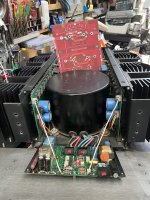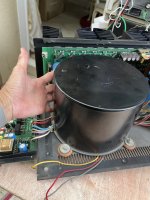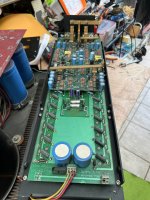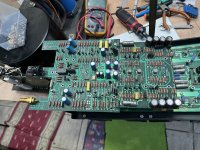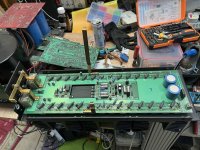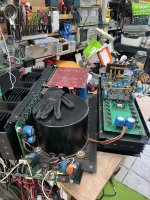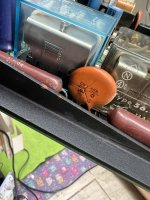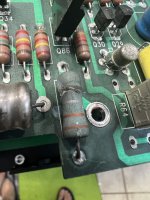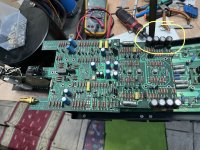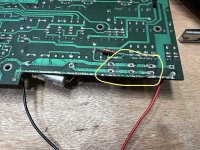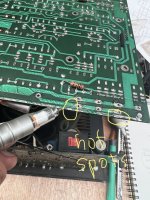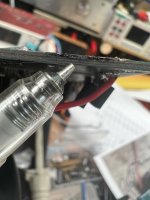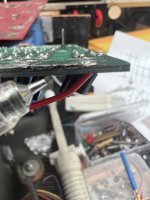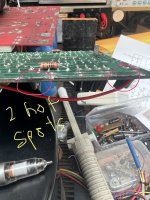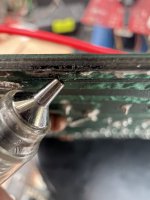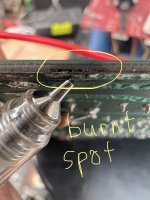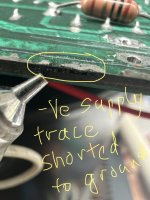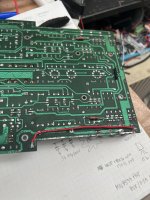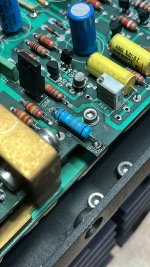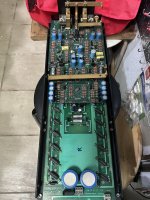Received a Krell KSA 250 for repair from Kuala Lumpur Malaysia. The owner is a friend of my friend in Singapore. The owner couldn’t find anyone to repair his amp.
One day he turned on the amp, the relays clicked and then he saw spark coming from the left channel and then relay clicked off. Subsequently couldn’t be turned on again.
It was a September 1991 date of manufacture so it’s 32 years old.

One day he turned on the amp, the relays clicked and then he saw spark coming from the left channel and then relay clicked off. Subsequently couldn’t be turned on again.
It was a September 1991 date of manufacture so it’s 32 years old.
Continue with disassembly. The toroidal transformer is a monster. Believed it’s 4.5KVA
Attachments
The 0.33 ohm resistor was open circuit upon measuring with ohmmeter. This appears to be part of RC filter on the negative rail of the driver board. A blown R would certainly indicate major fault down the line.
Tried searching the internet for a schematic of the KSA 250 without luck. So had to do the tedious way of tracing the circuit.
Tried searching the internet for a schematic of the KSA 250 without luck. So had to do the tedious way of tracing the circuit.
It appears that likely components that can result in a short are Q38,39,40,41,42,43. Checking these transistors showed that they were ok. Checking the 100uF 100V decoupling capacitor also showed ok.
There is no other components on this rail that could cause a short circuit to blow the 0.33 ohms resistor.
Measuring the negative rail node to ground shows a low resistance path of less than 10 ohms. Measuring the positive rail node to ground showed an expected open circuit.
Spent many hours probing around to determine the cause of short to no avail. Was running out of ideas.
There is no other components on this rail that could cause a short circuit to blow the 0.33 ohms resistor.
Measuring the negative rail node to ground shows a low resistance path of less than 10 ohms. Measuring the positive rail node to ground showed an expected open circuit.
Spent many hours probing around to determine the cause of short to no avail. Was running out of ideas.
Pumping a low voltage with current limit to 0.5A to the negative rail node to ground confirmed that a short is indeed present in the circuit.
Doing that I feel around the entire board to check for hot spots on components which I may have missed while tracing the circuit.
There was no heated components. However there was an area around the decoupling capacitor that was warm. The capacitors were not warm but the PCB was.
Doing that I feel around the entire board to check for hot spots on components which I may have missed while tracing the circuit.
There was no heated components. However there was an area around the decoupling capacitor that was warm. The capacitors were not warm but the PCB was.
The circled area was where the PCB felt warm. As mentioned earlier, the decoupling capacitor was checked to be ok and not leaky.
I removed all four electrolytic capacitors(100uF, 100V) to check if there was any metallic particle under the capacitors that could have caused the short.
I removed all four electrolytic capacitors(100uF, 100V) to check if there was any metallic particle under the capacitors that could have caused the short.
Attachments
I pump a controller voltage and current to the negative rail node to ground again. And this time I use a thermocouple to pinpoint the exact hot spot. There were two spots measuring around 60C with an ambient temp of 30C. The weird thing is that there is no components there besides the transistors Q38-43 which I had already checked to be ok.
Attachments
On closer inspection, I could see burnt mark from excessive heat. Also showing some degree of delaminating of the PCB.
Attachments
I am not 100% sure of the cause of the short but I suspect that this is not a simple two layer board. Krell may have used sandwiched ground plane (like a multiplayer board) to improve noise to achieve a higher signal to noise ratio. Due to some manufacturing random defects this part of the PCB trace got shorted to the internal ground plane. Solder whiskers?
I wired a jumper to bypass this defective PCB trace. Re-solder the capacitors. The short has been located and isolated.
Subsequent test of the repaired channel after reassembly showed that the problem is fixed.
Throughout my more than 50years of amplifier building and repair I have never encountered such a failed mechanism.
Would like to hear if anyone else has encountered such an incident.
Subsequent test of the repaired channel after reassembly showed that the problem is fixed.
Throughout my more than 50years of amplifier building and repair I have never encountered such a failed mechanism.
Would like to hear if anyone else has encountered such an incident.
Attachments
- Home
- Amplifiers
- Solid State
- Krell KSA Repair
